| 1 | The spookiest Thai snake |
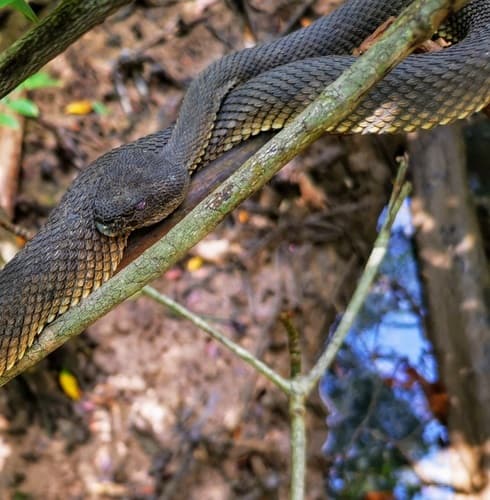
In southern Thailand, there’s a venomous snake which is easy to avoid, yet is extremely common in certain spots, and acts highly unpredictably when you meet them. This is the mangrove pitviper, a venomous species which lives exclusively in mangroves and wetlands, in coastal areas as well as wide rivers several miles inland.
Mangrove pitvipers measure 50-90cm, with females slightly longer. They vary significantly in appearance, as some are a stony grey with red eyes, others a mixture of olive and grey, and a few even with bright blue tinges. Mangrove pitvipers are usually encountered 0.5 to 3 metres high in branches, or slithering on the mud flats below. They have a large though not vast empire, beginning in central Thailand, covering the southwest coast (such as near Phuket), and spreading into peninsular Malaysia and Singapore, where they’re especially abundant. There’s also a colony in Sumatra, Indonesia.
This snake is strict about its habitats, as they’ll never appear in open fields or high altitude mountainous forests. They definitely won’t appear in inner city Bangkok like the white-lipped pitviper, their venomous cousin. With its love of gnarly branches overhanging gloomy swamps, this snake is more than capable of giving you nightmares.
| 2 | Unleashes itself like a spring |
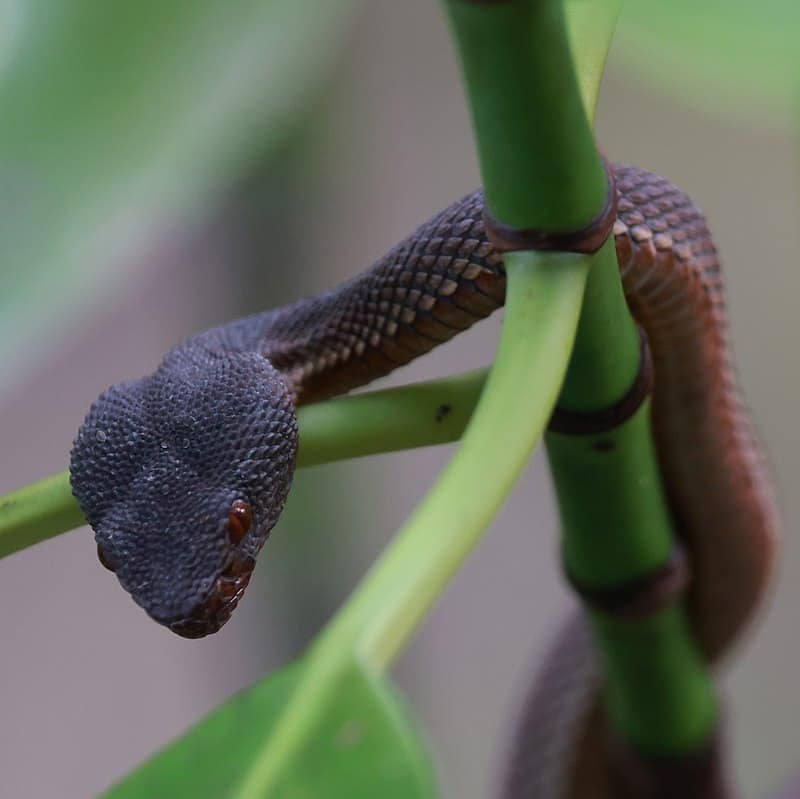
Mangrove pitvipers have almost no deaths to their name, but are renowned for their unpredictable temperament. They have an accurate strike, and their love of dim light and staying stationary means that many oblivious people don’t notice them until it’s too late. Thai locals gathering fiddler crabs have a particular tendency to meet the mangrove pitviper.
Like many Trimeresurus members, they shun high canopies, much preferring low branches and bushes – commonly at a human’s chest height. The mangrove pitviper has a prehensile tail, allowing it to fasten around a branch and strike in mid-air, unloading at a passing human like a jack-in-the-box. When preparing to strike, mangrove pitvipers coil into an S-shape, with their head facing forward and their neck bent sharply. Actually, it’s more like a double-S, with two joined together, as the curves continue unabated until their tail.
Though not quite as shocking, their inner mouth is snowy white like a cottonmouth’s. They slowly open and close their mouths before lunging, as a warning sign. Another trick is shaking their tail rapidly against well-vegetated branches, to produce a low buzz. This has led to a local Thai name of “Phangka rattlesnake”, even though no real rattlesnakes exist in the eastern hemisphere. Simply “Phangka” is another local name.
| 3 | Abundant in certain locations |
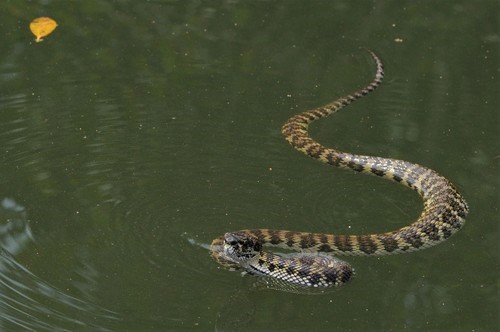
Mangrove pitvipers occupy over a thousand miles from north to south, but one spot undoubtedly has the highest density of sightings of anywhere in the world: the Sungei Buloh wetlands of Singapore. This is a bird-watching paradise, which is popular with tourists with a pencil and sketch book in hand, watching from the safety of wooden boardwalks. The murky waters also contain reticulated pythons, king cobras, oriental whipsnakes, painted bronzebacks, and paradise flying snakes, sometimes eating each other. It’s a nature wonderland, and mangrove pitvipers complete the lineup, potentially striking at people’s heads on the boardwalk’s relatively low areas, or resting quietly on the wooden railings.
Joint first is Singapore’s Pasir Ris Park, where sightings are constant. This is a popular beach mangrove park, again with wooden boardwalks, and more disturbingly, a family waterpark called Wild Wild Wet just next door, where mangrove pitvipers are occasionally sighted.
Another neighbouring attraction, more fittingly, is the Pasir Ris Tower, which was designed for bird-watching but is now a notorious suicide tower. Supposedly, a boy gifted with a third eye told his friends that he sensed supernatural spirits in the tower’s vicinity. A few days later, they saw the boy plummet from the tower, who told them with his dying breath that the spirits pushed him. A colony of dog-faced watersnakes shares Pasir Ris Park with the venomous mangrove pitvipers.
| 4 | Haemorrhaging and swelling |
Mangrove pitvipers have a classic viper venom. Unlike a black mamba or coral snake, there’s virtually no neurotoxins. Instead, like its rattlesnake cousins, the venom triggers haemorrhaging, blood clotting disruption, and swelling all the way up the affected limb. Deaths are only known in children, and it would probably take a fluke to kill an adult. The venom is injected in milliseconds, so it doesn’t matter if you rip the pitviper off your arm in a flash.
Breaking down the toxins, Trimeresurus purpureomaculatus is highly haemorrhagic, has moderate levels of direct anticoagulants, and moderate thrombin-like toxins, which accelerate the conversion of fibrinogen to fibrin, depleting blood clotting supplies. Phospholipase A2s are partially behind the swelling, while there’s very little hyaluronidase, which breaks down hyaluronic acid in the skin.
This venom may be used medically one day, as a 2020 study found that a unique distintegrin it contained called purpureomaculin preferentially targeted cancer cells, including lung, breast colon and prostate cancer cells.
| 5 | Effective antivenom (sort of) |
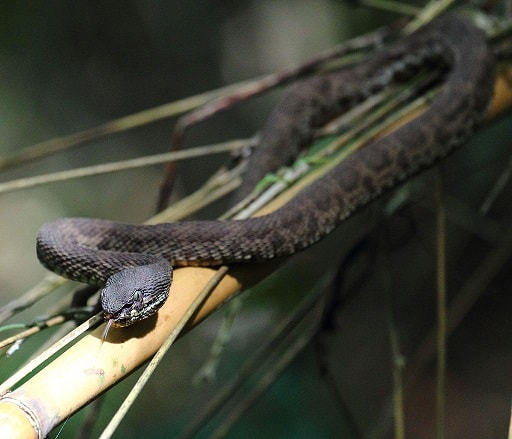
One bite case involved a 40 year old man who was bitten on the hand in Singapore, leaving two puncture marks 1cm apart. Swelling kicked off just 10 minutes later, which grew to cover his forearm by 1.5 hours post bite.
At 2.5 hours, antivenom was administered, followed by another dosage at 4.5 hours. But the swelling continued to advance until 12 hours, reaching his elbow and a maximum progression of the lower arm. Then it subsided, mostly disappearing by 72 hours, leaving the man with no lasting injuries. There were no major systemic effects.
Mangrove pitvipers are worrisome because they lack a dedicated antivenom. There’s so many pitvipers in southeast Asia that you can’t craft a specific vial for them all. But antivenom reared from white-lipped pitvipers has been shown to work effectively, according to a 2013 study, where it disabled much of the swelling in 1-2 days. This is Thailand’s most common pitviper, and the two cousins (both Trimeresurus members) evidently have a large toxin overlap.
| 6 | Bites are survivable (probably) |
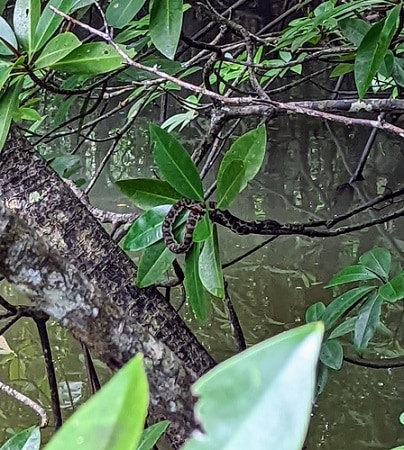
Meanwhile, a much older case showed what happens without a helping vial of antivenom. The pitviper was found on August 16th 1974 on a mangrove beach in Phuket, Thailand. It was 5 feet above the ground, curled inside the loose bark of a dead tree, a classic habitat for this species. It was relatively small, measuring 39.16cm.
The mangrove pitviper was scooped up and taken to its new captive home, where it happily gobbled up house geckos and young pink mice, achieving two skin sheds. The snake remained “extremely pugnacious”, and the harmony came to an abrupt end on September 10th, when it delivered a bite to the left thumb of one scientist. Only his quick reflexes prevented it from delivering a second bite.
The pain was immediate, and despite the wound being sucked hard for venom (they didn’t say who did the sucking), purple swelling and stiffness arrived at 3 minutes post bite. The doctor wrapped a tourniquet around the thumb, but the swelling arrived so rapidly that it had to be removed after 10 minutes, being shifted to the elbow.
| 7 | Symptoms can last 10 days |
By two hours post bite, the victim’s hand was completely swollen, and his four fingers were icy cold. His entire body felt chilled, and the swelling soon reached his forearm and elbow, spreading rapidly. The victim had a disturbed night of sleep, and by the next morning (11th), the swelling had reached his upper arm.
The victim tried to leave his bed, but felt nauseous and dizzy, forcing him to return to his air-conditioned room. Blisters then formed around the wound, which released a clear liquid when lanced. By the 12th, the swelling had finally reached his armpit, but at 15:00 that day, nearly two days after being bitten, the swelling on his thumb and hand began to subside, although the wound was oozing liquid.
The swelling remained strong until the 14th, 4 days post bite. By the 16th, only his thumb lacked full manoeuvrability, and only the thumb and upper arm were slightly swollen. However, there was now a small necrotic area of flesh surrounding the bite mark, along with the oozing blisters.
By the 20th, ten days after being bitten on the 10th, the victim was finally healed. The only symptom was a slightly swollen thumb, which was slightly painful when flexed. The man had fought off a mangrove pitviper bite all by himself, revealing a mainly localised venom, though with the caveat that this was a small individual (39cm), and larger snakes could deliver a heftier dosage.
| 8 | Be careful on wooden boardwalks |
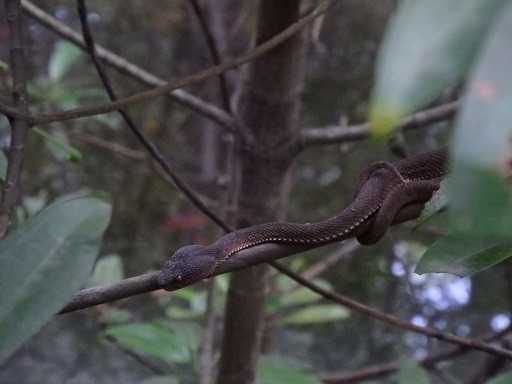
Trimeresurus purpureomaculatus lives exclusively in mangroves and wetlands, and a 2017 study delved deeper into their habitat. It examined 6 mangrove pitvipers from a protected wetland in Riau province, Indonesia. It found that mangrove pitvipers didn’t completely shun artificial habitats, as they were spotted near manmade objects like docks and guardhouses built for the tourism industry, and hid below a roof at a timber site. One was resting flat on a wooden boardwalk, rather than clinging to branches.
Another was found hiding inside a tree hollow, two slithering along a stem, and another resting on low a branch. Their favourite height was 0.5 metres above ground, and one consistent feature was that they loved low light intensities. For 5 out of 6 mangrove pitvipers, the light level was described as “low”, while the other was “extremely low”, all due to lurking beneath the canopy. This is a shadow snake, a lover of gloomy places where it can quietly lurk, and terrify innocent Thai people trying to hunt crabs to boil.
The mangrove pitvipers were sensitive to tides, which they avoided by climbing low branches. The study also found two colour morphs living in the same location; bright olive and dark purple.
| 9 | Eats a helping of snakes |
One of the most mysterious aspects of the mangrove pitviper is its diet. With monocled cobras, also common in Thailand, we have a study showing that mammals make up over 70% of their prey. With mangrove pitvipers, there’s just scattered sightings here and there. They swallow pinkie mice and house geckos happily in captivity, while they’ve also been spotted swallowing up fellow snakes.
The subject was a mangrove crab-eating snake (Fordonia leucobalia), a classic species they coexist with in dark, muddy Thai wetlands. In November 2014, the crab-eating snake was spotted writhing in mud, apparently dying. They then noticed another snake tailing it, a mangrove pitviper, which had almost certainly just envenomated its victim, and was in hot pursuit, tracking using scent particles in its own injected venom. This happened in Singapore’s Pasir Ris park, the hotspot we discussed earlier.
5 minutes later, the pitviper reached the snake and commenced swallowing, which took 24 minutes. The most interesting thing was how it used a tree root for leverage. It cleverly anchored its tail, while it walked its jaws over the smaller snake and forced it down its throat. The pitviper then did a classic snake “yawn” and slithered off.
| 10 | Preyed on by king cobras |
Viper remains have also been found in the mangrove pitviper’s belly, believed to be from their own species. In an investigation of its venom, again in Pasir Ris Park, scientists unearthed snake bones in 3 separate mangrove pitvipers. One was found alongside a partially digested crab claw, hinting that it was Fordonia leucobalia again, or the cat-eyed watersnake, another crab-eating snake. Mangrove pitvipers clearly eat snakes, but exactly how much they contribute to their diet is unknown.
Ophiophagy also works against the mangrove pitviper, as the almighty king cobra is confirmed to snack on them. This time, the observation took place in Singapore’s Sungei Buloh Wetland Reserve. The king cobra was slithering along a trail, like it had every right to be there. It spotted a juvenile mangrove pitviper resting on the wooden railing, but ignored it. The king cobra then headed down to the cool mudflats, and over an hour later, it found a larger, more rewarding meal: an adult mangrove pitviper resting on a branch.
This time, its interest was piqued. The pitviper sensed danger, and dropped 3 metres to the mudflats below. But this was a mistake, as the king cobra rapidly slithered over and bit the mangrove pitviper on its neck, maintaining a firm hold. The mangrove pitviper died 30 minutes later, and was swallowed by the greedy king cobra, which had already eaten a dog-faced watersnake the same day.
